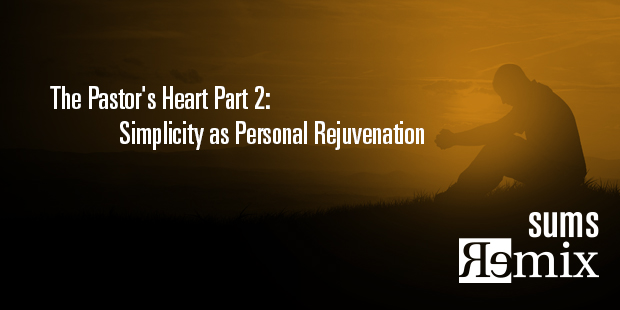
How to Focus Better by Failing Faster
Congratulations – your church has just completed its third year in a row of growth! Weekend worship attendance is growing at 20% per year; your offerings are ahead of budget; and participation in small groups has increased steadily toward your goal of 75% of worship attendance. These are only the leading indicators of a successful growth curve.
While your church may not fall exactly into one or more of those growth indicators, success is likely happening in some area of ministry.
But beware – success brings its own new problems everyday. What were once easy decisions in your church four years ago now have now become complicated, cumbersome, and confusing. Your leadership team has likely grown, and chances are, your leadership in terms of group dynamics and interpersonal communication has not kept pace.
It is time to stretch your personal development and lead your church to stay focused and make timely decisions. If you are experiencing success and feeling the resulting complexity, consider failing fast.
THE QUICK SUMMARY Design to Grow, by David Butler
In today’s world, every organization is at risk of having a “Kodak Moment” – watching its industry and the competitive advantages it has developed over years, even decades, vanish overnight. The reason? An inability to adapt quickly to new business realities.
Established companies are at risk, but it’s no easier being an agile startup, because most of those fail due to their inability to scale. Tomorrow’s business winners—regardless of size or industry—will be the ones that know how to combine scale with agility.
In Design to Grow, a Coca-Cola senior executive shares both the successes and failures of one of the world’s largest companies as it learns to use design to be both agile and big. In this rare and unprecedented behind-the-scenes look, David Butler and senior Fast Company editor, Linda Tischler, use plain language and easy-to-understand case studies to show how this works at Coca-Cola—and how other companies can use the same approach to grow their business.
A SIMPLE SOLUTION
Church leaders usually treat failure of an activity or initiative as something to be avoided at all costs. The “F” word frightens us to no degree because we have been told that to admit failure means that you are a failure. Fail once and you’re a failure.
So engrained in our culture is this tenacious notion that we tend to forget that the most common experience to all of us is the experience of having failed at something. We all have plenty of failures in our personal and organizational lives.
However, in a fast-paced and growing organization, it is actually very important to fail fast. This doesn’t mean that you should be aiming for failure of course, but instead be willing to recognize failure and accept that failure quickly and logically.
Trying to avoid failure on something can lead to more time and money being wasted unnecessarily.
There are two key benefits to failing fast:
- Learn from mistakes
- Find success faster
By learning to fail fast, organizations can learn faster and become smarter, which reduces the risk of being disrupted.
New ventures don’t have the kind of resources big organizations do in people, time, or money. Living in a world that could literally end tomorrow, they don’t have the luxury of fearing failure. They must embrace it. In fact, they try to fail as quickly as possible so they can move on to the next thing – whatever that might be.
Any organization or team can launch a new project, campaign, or initiative the way startups do. Learning what people need or want, building a prototype, measuring what worked and what didn’t, then doing it all over again, are techniques that anyone can embrace.
If you have a problem with the idea of failure, substitute the word learn, since failing faster essentially means learning faster. Each failure makes you smarter by helping you better understand what works.
David Butler, Design to Grow
A NEXT STEP
The failure of an idea or activity did not occur in the event itself – it was a journey from concept to completion that included many decision points along the way. In order to gain the most benefit from a failure, take your leadership team in a time machine journey back to the beginning
At your next staff meeting, identify a recent “failure” at the top of a marker board on the farthest point on the right. Be careful to separate the leadership behind an event from the actual event that was less than successful. If you are the senior leader at the table, consider leading with a failure from your sphere of influence, and in humility undertake this exercise to model leadership for your team.
First, explore some of the “why” behind the failure label, making a list of reasons. Highlight the main verb or action.
Next, draw a horizontal line extending from the failure all the way to the left side of the marker board.
Ask what significant decision, action, or moment happened right before the failure, and write to the left of the failure, again highlighting the main verb or action. Repeat this question with each successive step.
Now, repeat this process from right to left, until you have an overview of all the events that led up to the particular situation.
Review the sequence of events, noting probable cause and effects. On a chart tablet, write key learnings from this exercise that can be applied to your next idea or activity and identify at least one system or process change to make as a result.
Don’t be discouraged by your success – as Auxano Founder Will Mancini writes in Church Unique:
Every leader must contend with clarity gaps and complexity factors. Clarity gaps are the logical areas where obscurity and confusion enter the leader’s communication world. Complexity factors literally wage war against the leader’s practice of clarity by making it difficult to maintain focus. When it comes to clarity, new levels bring new devils. The higher the leader goes, the harder the leader must work to stay clear.
Taken from SUMS Remix 23-2, published September 2015
This is part of a weekly series posting content from one of the most innovative content sources in the church world: SUMS Remix Book Summaries for church leaders. SUMS Remix takes a practical problem in the church and looks at it with three solutions; and each solution is taken from a different book. As a church leader you get to scan relevant books based on practical tools and solutions to real ministry problems, not just by the cover of the book. Each post will have the edition number which shows the year and what number it is in the overall sequence. (SUMS provides 26 issues per year, delivered every other week to your inbox).

Tags: David Butler, Design to Grow, Fail Fast, SUMS Remix
























